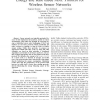Free Online Productivity Tools
i2Speak
i2Symbol
i2OCR
iTex2Img
iWeb2Print
iWeb2Shot
i2Type
iPdf2Split
iPdf2Merge
i2Bopomofo
i2Arabic
i2Style
i2Image
i2PDF
iLatex2Rtf
Sci2ools
SIGMOD
2003
ACM
2003
ACM
Energy and rate based MAC protocol for wireless sensor networks
Abstract-- Sensor networks are typically unattended because of their deployment in hazardous, hostile or remote environments. This makes the problem of conserving energy at individual sensor nodes challenging. S-MAC and PAMAS are two MAC protocols which periodically put nodes (selected at random) to sleep in order to achieve energy savings. Unlike these protocols, we propose an approach in which node duty cycles (i.e sleep and wake schedules) are based on their criticality. A distributed algorithm is used to find sets of winners and losers, who are then assigned appropriate slots in our TDMA based MAC protocol. We introduce the concept of of energy-criticality of a sensor node as a function of energies and traffic rates. Our protocol makes more critical nodes sleep longer, thereby balancing the energy consumption. Simulation results show that the performance of the protocol with increase in traffic load is better than existing protocols, thereby illustrating the energy balancing nature...
Related Content
| Added | 08 Dec 2009 |
| Updated | 08 Dec 2009 |
| Type | Conference |
| Year | 2003 |
| Where | SIGMOD |
| Authors | Rajgopal Kannan, Ramaraju Kalidindi, S. Sitharama Iyengar, Vijay Kumar |
Comments (0)

